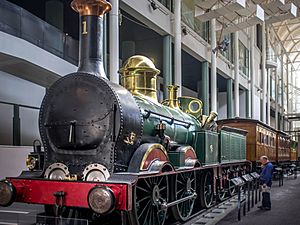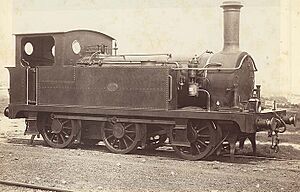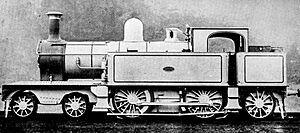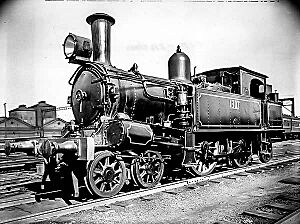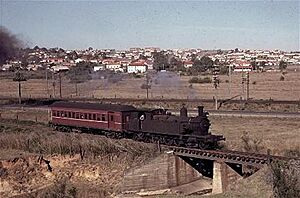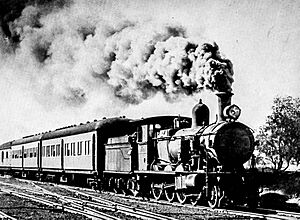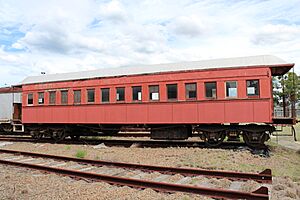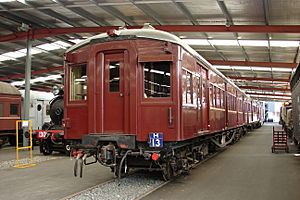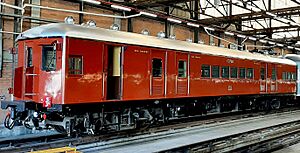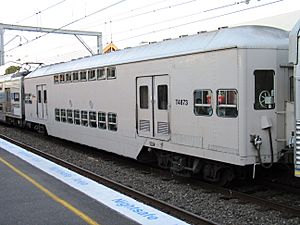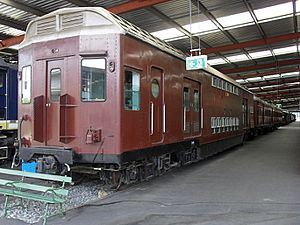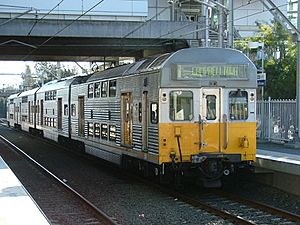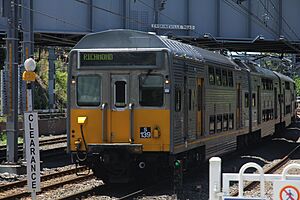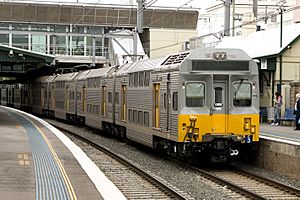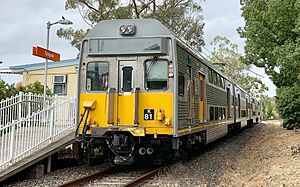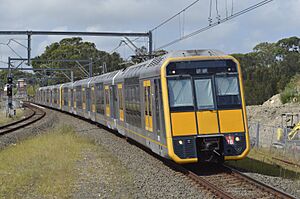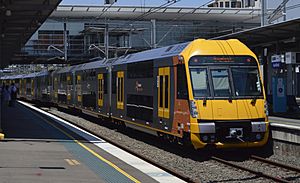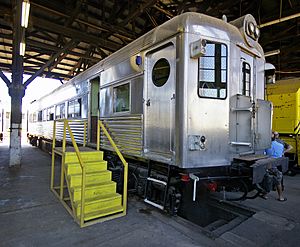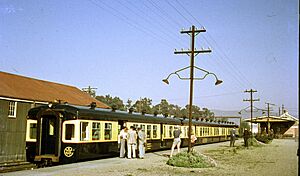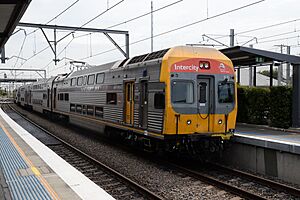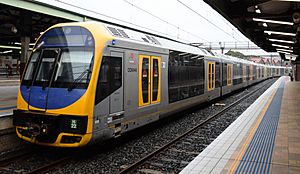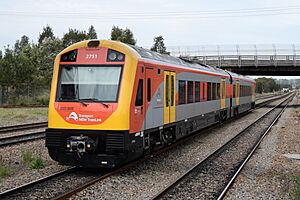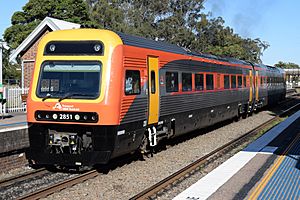Rail rolling stock in New South Wales facts for kids
The trains in New South Wales, Australia, have many different types of passenger and freight cars. The very first railway line in Sydney opened in 1855. It ran between Sydney and Granville, which was a big farming area back then. This railway line was the start of the New South Wales Government Railways. Right from the beginning, trains carried both people and goods. By 1880, trains were running every half hour to Homebush.
Contents
- Old Suburban Passenger Trains
- Current Suburban Passenger Trains
- Sydney Metro Trains
- Old Inter-Urban Passenger Trains
- Current Inter-Urban Trains
- Old Regional Passenger Trains
- Current Regional Passenger Trains
- Intercity/Regional Passenger Locomotives
- Light Rail Trains
- Train Codes
Old Suburban Passenger Trains
Steam Locomotives for Suburbs
M36 Class Locomotives
In the late 1860s, four more trains like the 1 class were built by Mort's Dock & Engineering Company in Sydney between 1870 and 1871. Another four M.36 class trains were made at Eveleigh Railway Workshops in 1876–77. They used parts from older trains. Two of these trains later had small shelters added to their tenders for suburban trips.
Z18 Class Locomotives
In 1882, an order was placed for six special trains from the Vulcan Foundry. These trains were supposed to have a 2-4-0T wheel setup. However, the design was changed to a 0-6-0T wheel setup with smaller wheels. The idea was that these new trains could go up to 33 miles per hour in suburban areas.
The six trains arrived in 1884. Their small wheels made them too slow for suburban passenger service. So, they were mostly used for moving other trains around in Sydney Yard.
In 1907, these trains got new boilers, which made them heavier and helped them grip the tracks better. In 1922, they were the first trains in New South Wales to get power reversing gear, but this was soon changed back to a simpler system.
After the Sydney train network became electric in 1927, these trains were used for depot work. Some even had cranes attached! Later, they worked at Port Kembla moving trains. One train, No. 1802, was sold in 1927 and worked until 1964. Two others were sold in 1957 and worked on a coal railway until 1963.
F351 Class Locomotives
These trains were first ordered in 1879. A new order was made in 1882 for 2-4-0 tank trains. However, this order was also changed, leading to the R285/Z18 class trains instead.
In 1884, more trains were needed for the new Illawarra line. The F351 class trains were designed and built by Beyer, Peacock & Company. They started running on the Sydney suburban network in 1885–86. Six more were delivered in 1887.
These trains were known to wobble a lot at high speeds and were limited to 30 miles per hour. In 1901, after a serious accident where one of these trains was going too fast, the entire class was taken off passenger duty. They were then used for shunting (moving trains around) and other yard duties. Some were even modified to try and make them more stable.
Between 1906 and 1929, ten of these trains were sold to private railway companies. By 1914, all of them were no longer used for passenger work. Some of these trains were rebuilt with new boilers and other changes. One train, 1042, was still working in February 1973, when it was almost 86 years old!
Z11 Class Locomotives
The Z11 class trains were built by Beyer, Peacock & Company in England. They started running in Sydney's suburbs in 1891.
These trains were meant for hilly sections of track, so they were quite heavy. This weight later made them not very good for speed. Between 1906 and 1910, they were rebuilt with new boilers. Soon, newer trains replaced them, and the Z11 class trains were moved to Newcastle for suburban services. In 1924, they were renamed the Z11 Class.
Some of these trains were sold to other companies. The rest were sold for scrap metal between 1925 and 1927. None of these trains have been saved.
Z13 Class Locomotives
Because there weren't enough suburban trains in Sydney, it was decided to try converting an older type of train, the C79 class, into a tank engine in 1896. This worked well, and by 1902, twenty of these trains had been converted at Eveleigh Railway Workshops. In 1924, they were renamed the Z13 class.
When newer trains arrived from 1903, the Z13 class trains were moved to Newcastle for suburban services. After that, they took on smaller jobs, like working on branch lines to Carlingford, Morpeth, and Warren. Some were sold to coal companies, and one was scrapped.
In their later years, they mainly worked on the Ballina branch line, the Picton-Mittagong Loop line, the Yass Town branch, and school trains on the upper North Coast.
C30 Class Locomotives
The first 35 of these trains were built by Beyer, Peacock & Company and started service in 1903/04. More were built until 1917, with some also made at the New South Wales Government Railways' Eveleigh Railway Workshops.
When the inner suburban lines became electric, there were too many of these trains. So, between 1928 and 1933, 77 of them were changed into C30T tender trains. These new trains were used on country branch lines.
The remaining C30 tank trains mostly worked on Sydney suburban lines to Cowan, Penrith, and Campbelltown. They also ran on branch lines to Carlingford, Richmond, and Camden. You could also find them on suburban services in Newcastle and Wollongong.
A few of them ended up in country areas, especially where there were no turntables to turn the trains around. They also shunted (moved) trains in yards like Bathurst. These trains even operated daily passenger services on the very steep Unanderra to Moss Vale line until 1967.
The first C30 train was taken out of service in 1957. By 1971, only three were left. The very last one, 3085, was removed on February 22, 1973. It was the second-to-last steam train still running in New South Wales.
Single-Deck Passenger Cars
1877 American Suburban Carriages
Main article: New South Wales American Suburban carriage stock
The American Suburban Carriages were built between 1877 and 1912. They had wooden frames and doors at each end with covered platforms. A total of 659 of these carriages were built, making them the most common type of carriage in Australia. Another 196 similar carriages, called Lucy Suburban Carriages, were built later with steel frames.
These carriages were mainly used for suburban passengers in Sydney. After the Sydney network became electric in the 1920s and 1930s, most were changed for longer trips. Others were sent to Newcastle and Wollongong for continued suburban use or to country branch lines. The last ones were taken out of service in the mid-1970s.
Many American Suburban carriages have been saved. You can see examples at the Canberra Railway Museum, Dorrigo Steam Railway & Museum, Lachlan Valley Railway, and NSW Rail Museum.
1920 Wooden Single-Deck Cars
In the 1920s, the Bradfield plan to electrify the train lines began. Before this, trains were pulled by steam engines and had wooden cars with end platforms. In 1921, 101 wooden motor cars were built. These cars were originally pulled by steam engines, but they were changed to electric trains when the first electric line opened in 1926. These wooden cars had steel covering for extra strength and became known as the Bradfield cars.
Some Bradfield cars were turned into parcel vans after accidents. Others were rebuilt in the 1960s to look like newer "Standard" cars, to keep them running until new double-deck trains arrived. The last Bradfield power cars were taken out of service in 1975. One, C3045, is saved at the NSW Rail Museum in Thirlmere. Another, C3082, is kept by RailCorp.
At the same time, 193 steam-hauled cars were rebuilt into electric trailer cars. These stayed in service much longer than planned. They were finally replaced by newer single-deck and then double-deck trailer cars from the 1950s onwards. One trailer car, T4279, is preserved and has been used on many special train tours.
1925 All-Steel Cars

When the Sydney underground lines were planned to open and become electric, it was decided to build steel suburban cars. Since no such cars had been built in Australia before, the first 50 cars were made by the Leeds Forge Company in England. They were put together in Australia between April and October 1925. These cars were first used with steam engines, then later fitted with electric equipment in 1926. They were then renumbered from C3101 to C3150.
1926–1960 Single-Deck Steel Cars
Between 1926 and 1960, a total of 417 motor cars and 417 trailer cars were built by different companies. The pre-war "1927 type" cars were called "Standard" cars because they were the most common suburban trains. They had First and Second Class travel until 1940. More cars were delivered later to help with the growing train system and replace older wooden trailer cars. The 80 cars built from 1957 to 1960 were known as the Sputnik cars. They had four power-operated doors on each side. These cars were introduced when the electric line was extended from Parramatta to Penrith.
These single-deck electric trains were the main trains on the Sydney suburban network until the newer stainless-steel double-deck trains took over. The last of the Sputniks were retired in 1993. Many cars were painted blue and white in the 1970s, and later a deep 'Indian Red'. In their final years, these cars were called 'red rattlers' because their windows and shutters rattled. On June 10, 2016, some preserved cars were brought back into service by Sydney Trains and now operate special trips. At 90 years old, this train set, called Red Set F1, is one of the oldest working electric train sets in the world.
Double-Deck Passenger Cars
1964 Tulloch Double-Deck Trailers (1964–2003)
In the 1960s, plans were made for double-deck electric passenger cars. In 1964, the first of 120 Tulloch trailers were delivered. These cars were added to the single-deck train sets. They were built by Tulloch Limited. These cars had a normal floor level over the wheels, with a double-deck passenger section in between. They were mostly made of aluminum with steel frames. They had green interiors and were painted Tuscan Red on the outside with silver roofs to match the single-deck carriages. For the first time in Sydney, these trains had fluorescent lights inside and air suspension.
The Tullochs were painted in the colors of the time (blue & white, then deep Indian red). Some were later painted grey and used with newer double-deck trains. The last Tulloch trailers were taken out of service in 1994 when all single-deck suburban trains were retired. Some cars that ran with newer power cars stayed in service until February 2004. Many Tulloch cars have been saved for preservation.
1968 Prototype Double-Deck Power Cars (1968–1980)
In 1966, after the success of the Tulloch double-deck trailers, plans were made for double-deck motor cars. In 1968, four experimental double-deck motor cars were built by Tulloch. These cars allowed the first eight-car double-deck train to run. These were the first fully double-deck electric trains in the world with seating on both the upper and lower levels.
Each power car had electrical equipment from different companies to test them out. This experimental train set was not very reliable. In 1977, it was decided to change these motor cars into trailers. Two of them were converted, but one was scrapped. C3804 is now preserved at the NSW Rail Museum in Thirlmere. It was taken out of service on January 4, 1980.
These trains operated on several lines, including the South Line, Inner West Line, and East Hills Line.
1972 Comeng Power Cars
In 1972, the first Comeng-built stainless steel double-deck power cars started running. These cars were similar to the recently introduced inter-urban trains. Their stainless-steel bodies were painted the standard "Tuscan red" to match the existing trains. Later cars were delivered in blue and white, then repainted red, and finally stripped to show their original stainless steel. They were first used with Tulloch trailers. Inside, they had reversible seats and a grey and off-white interior. They had sliding windows, which were later replaced with Hopper windows. These motor cars had tapered ends, which got destination boards in the 1990s. When the Millennium Trains were introduced in 2002, some early Comeng power cars were changed into non-driving trailers.
1973 Comeng Power and Trailer Cars
In 1973, more Comeng power cars and trailer cars were ordered for the opening of the Eastern suburbs railway line. These trailer cars were the first to be made of stainless steel. They had an extra row of seats on the top deck. Ten driving trailer cars were built, but they were never used for driving due to union rules. Later, more driving trailer cars were built to allow 2-car trains to operate. Some driving trailers were pulled by diesel engines on the South Coast suburban services before electrification. Others were used for short 2-car trips on the Richmond line. These driving trailer cars later had their driving equipment removed and became regular trailer cars. By 1976, one quarter of suburban cars were double-deck. All the 1973 cars are now mixed with older trains and run as L, R, and S Sets. When the Millennium Trains were introduced in 2002, some early Comeng power cars were changed into non-driving trailers.
1978 Goninan Cars
In the 1970s, A Goninan & Co in Newcastle started building passenger cars. They built 80 power cars and 70 trailer cars. Unlike the Comeng cars, the Goninan power cars had a flat front. Also, the upper deck windows were set lower, which passengers didn't like because it made it harder to see out. When the Eastern Suburbs Railway opened in 1979, only stainless-steel double-deck cars were supposed to run on it, but painted Tulloch double-deck trailers were also used. In 1981, a brand new four-car Goninan set carried Queen Elizabeth II from Bankstown to Martin Place. This train was specially decorated with carpets for the occasion. These cars continued to operate until 2007 as L, R, and S sets. They were the last non-air conditioned passenger trains in Sydney.
Two-thirds of the older non-air conditioned trains were removed from service when 626 new A set Waratah carriages were introduced from 2012 to 2014. The last of these trains were supposed to be retired by 2015, but some were kept for the South West Rail link. In December 2016, the NSW Government ordered 192 new Waratah carriages, known as the Sydney Trains B sets. These replaced the remaining non-air conditioned S set trains by June 2019.
1986 Goninan Cars
In 1986, a new type of advanced suburban passenger train was being planned. While waiting for these new trains, 56 temporary stainless steel air-conditioned cars were built by Goninan. These were called 'Chopper Cars' because of their special control system. These cars tested out new features like fixed seating, door chimes, and passenger announcement systems. They originally had push-buttons for passengers to open doors, but this feature didn't last long. They had the same flat ends as the previous Goninan cars, but with a fiberglass front piece that was originally white with orange and red stripes. These ends were later painted grey with a yellow section. These cars were first called K Sets, but they didn't work well with the existing K Sets, so they were renamed C sets.
They continued to operate until newer trains started arriving in late 2020. The last C set train was taken out of service on February 26, 2021. A farewell tour took place on March 6. One 4-car set will be preserved.
Current Suburban Passenger Trains
1981 Goninan Power and Trailer Cars
In 1981, Goninan built the first air-conditioned cars for the Sydney suburban network. Before this, Sydney was behind other cities that already had air-conditioned trains. To fit the air-conditioning equipment into the motor cars, the pantographs (the arms that collect electricity from overhead wires) were moved to the trailers. This meant a motor car had to stay connected to a trailer car. Four driving trailer cars were also ordered, allowing 2-car sets to run. The first 8-car set was delivered with air-conditioning.
The first 100 cars had their upper deck windows at a lower height, which was not popular. The final 60 cars were modified, and their front ends were painted in the 'candy' white, orange, and red colors of the time. The last batch also had bright yellow internal walls. The cars that originally had forced ventilation were later fitted with air-conditioning, and their sliding windows were replaced with fixed ones in the late 1990s. At this time, the standard light grey interior was adopted, and the seats were changed to blue. A total of 160 of these cars were delivered until 1985, and they continue to operate today as K sets.
T Set (Tangara)
In 1988, the "third generation" train, called Tangara (an Aboriginal word meaning "to go"), was introduced. This train was very different from previous double-deck designs in both looks and technology. The Tangara was the last electric train bought with public money for CityRail. A total of 450 T set cars were introduced between 1988 and 1994, which allowed all the remaining single-deck suburban passenger cars to be removed from service by 1993.
Eighty G set cars were built between 1994 and 1996. These had toilets, high-backed seats that could be reversed, and controls for passengers to open doors. They mostly ran on outer-suburban routes to Wollongong, Springwood, and Gosford, though they sometimes ran in suburban service too. These outer-suburban sets allowed the last single-deck U sets to be retired in 1996. One set, G7, was badly damaged in the Waterfall rail accident in January 2003 and was scrapped.
In 2010, a program began to update all Tangaras, as they were nearly 20 years old. This work included new seat covers, flooring, handrails, and a complete repaint inside. The former outer-suburban G sets have been renamed as T sets from T101 onwards.
M Set (Millennium)
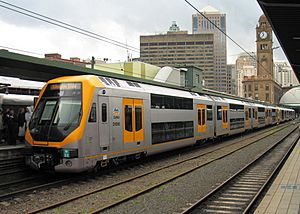
From 2002, 140 "fourth generation" carriages were introduced. These trains allowed the Tulloch trailer cars to be retired. These were the first passenger trains in NSW to have automatic passenger information displays and announcements. The design of the M sets was used as a base for the design of newer trains. These trains are maintained by Downer Rail at the Auburn Maintenance Centre.
While the Millennium trains can be divided into four-car sets, they are usually kept as eight-car sets at all times.
A & B Sets (Waratah)
The Waratah trains are double-deck, air-conditioned trains based on the Millennium trains. An order was placed for 78 sets of eight cars each. The train bodies were built in China and finished in Newcastle, New South Wales by a joint project. They were delivered between 2011 and 2014 to replace the older R & S Set trains. The first set started regular service on July 1, 2011, on the Macarthur–East Hills–Airport line.
The New South Wales Government announced on December 1, 2016, that 24 new suburban trains had been ordered. These trains are officially called B sets and are also known as Waratah Series 2 trains. The first B set was shown in Auburn in March 2018. After months of testing, Set B2 was the first to start passenger service on September 7, 2018. The B sets replaced the remaining S sets by the end of June 2019. In February 2019, another 17 B sets were ordered.
Sydney Metro Trains
Metropolis Stock
22 Sydney Metro Metropolis 6-car train sets started service when the Sydney Metro opened in May 2019.
Old Inter-Urban Passenger Trains
U Set Electric Multiple Units
The first 80 electric interurban passenger cars were introduced from 1958. This was to match the electrification of the Blue Mountains line to Bowenfels. These trains looked similar to the single-deck steel suburban cars but were a bit narrower. They were made of unpainted stainless steel and had connections between the cars. These trains were known as 'U Boats'. They had First and Second Class seating until 1974, when they became "one class." First Class had blue seats, carpet, and ashtrays in the smoking section. They ran from Lithgow/Bowenfels and Gosford to Port Kembla, Dapto, and Newcastle until they were finally removed from service in 1996.
Many of these trains have been used on special tours since the 1960s. Three power cars and two trailer cars have been preserved by the Sydney Electric Train Society. Other U-boat cars have been saved privately.
620/720-Class Diesel Rail Motors

Eighteen two-car self-propelled 620/720 class railcars were introduced between 1961 and 1968. They were built at the New South Wales Government Railways' Chullora Railway Workshops. These were the last passenger railcars built by government workshops in NSW. They were designed for Newcastle suburban and regional services, but they also ran on Wollongong services before electrification, and rural services to Cowra, Mudgee, Grafton, and Murwillumbah. Three sets had first and second-class seating for country services, while the rest were single-class.
They served non-electrified and pre-electrified parts of the Sydney suburban and interurban networks. They ran on the Richmond line until it was electrified in the 1990s. After many country services were removed and the South Coast Line and Richmond line were electrified, they served the Far South Coast line and the Southern Highlands line. When they were first introduced, they were painted Tuscan red. From the 1970s, some were Indian red. In the 1980s, they got a 'candy' livery with bright red, orange, yellow, and white stripes. In the 1990s, they were repainted to look like the old Tuscan scheme, and then later got a grey and blue CityRail livery. After the Endeavour railcars were introduced in 1994, their numbers were reduced, and they were all removed from service in 2007.
Several of these sets have been saved. One set, 621/721, has been repainted to its 1960s deep Indian red look.
SMR Railmotors
The South Maitland Railways railcar was a type of diesel train built by Tulloch Limited for the South Maitland Railway (SMR) in 1961.
After all their carriages were destroyed in a fire in 1930, the SMR had the New South Wales Government Railways (NSWGR) operate their services. However, this was losing a lot of money, so SMR decided to use diesel railcars to cut costs.
In 1959, an order was placed with Tulloch Limited, and all the railcars were delivered for services to start on October 1, 1961.
Tulloch designed the railcars with help from Tube Investments of England. The car bodies and frames were made of mild steel. After they were built, the railcars were tested on the NSWGR network around Sydney, even going as far as Penrith.
They operated all services on the line from Cessnock to Maitland, except for the daily Cessnock Express to Sydney. All were painted royal blue and yellow. In January 1967, all SMR passenger services were cancelled, and the railcars were stored. After attempts to sell them failed, they were scrapped in 1977.
1100 "Budd" Railmotors
The 1100 class railcar or Budd railcar is a type of diesel train built by Commonwealth Engineering for the New South Wales Government Railways in 1961. They mainly operated on the South Coast Daylight Express until they were removed from service in 1993.
1200 Tulloch Railmotors
In 1968, an order was placed with Tulloch Limited for 10 railcars for the Riverina Express. These trains were delivered between October 1970 and May 1972. While waiting for enough cars to run the service, some were used on other lines. Two similar vehicles were also built for Victorian Railways.
The ten cars were built in two types: one with a buffet (food service) section and seating, and the other with more seating and a luggage area. The goal was to have two four-car trains, plus spare cars.
They started service on the Riverina Express in May 1972. The idea was that the train could split at major stations, with cars going to different towns like Cowra, Tumut, Lake Cargelligo, and Hillston. On the way back, the cars would join up again to form one train back to Sydney.
The 1200s soon started having problems, especially with their complex electrical system. After one car had a damaged engine frame, all of them were removed from service in January 1973. One set of four was returned to service three days a week, with other trains running on the other days. These remaining cars were removed in October 1975.
In May 1974, two cars were sold to Victorian Railways. In 1977, four were converted to run an exhibition train around New South Wales for the Silver Jubilee of Elizabeth II. Three more were used with the 1100 class railcars on Illawarra line services. In 1981, it was decided to convert some of these cars into trains that could be pulled by locomotives. They were then used on the Illawarra line between Sydney and Bomaderry.
They sometimes ran on the Canberra Express and Newcastle Flyer in January 1986.
After locomotive-hauled South Coast services stopped in January 1991, they were moved to operate services on the Main South line to Moss Vale and Goulburn.
In February 1993, six of the carriages were lightly refurbished before being removed from service in November 1993. In August 1994, six were sold at auction.
Current Inter-Urban Trains
V Set
Introduced from 1970, these double-deck interurban cars actually came before the first full suburban double-deck sets. They were described as the 'most luxurious commuter stock in the world' at the time and set new standards for passenger comfort in Sydney. They first ran on the Central Coast & Newcastle Line. They could be used on the Blue Mountains Line after the Glenbrook tunnel was made wider in 1975. They could go as far as Lithgow after the Lithgow tunnels were widened in 1979. Services began on the Illawarra line after electrification in 1985.
The original 1970 cars were not very successful and were rebuilt into trailers to run with later intercity cars in the early 1980s. The second series of V-Sets started to be phased out in early 2011, replaced by the Oscar. When NSW TrainLink was created in 2013, the V sets were refurbished. This involved repainting and refitting the interior with new seat upholstery and a new exterior paint scheme. The rest of the V sets are expected to be replaced by 2024 when the D sets are introduced.
H Set (OSCAR)
The H sets, or OSCAR (Outer-Suburban CAR) trains, started running on April 24, 2006. The H sets were mainly built to replace the G set Tangaras on outer-suburban services and the original V sets. They have similar reversible seating to Hunter railcars and one toilet for disabled passengers per four-car set. The areas near the doors have seats along the side and hand-grips on the ceiling. They run to Newcastle Interchange, Port Kembla, and Kiama. These cars were built by UGL Rail. When the D sets are introduced, the H sets will also be moved to the Sydney Trains suburban network.
J Set (Hunter)
In 2006, 14 J sets, or Hunter railcars, were ordered to replace 620/720 class railcars. They are a new type of diesel multiple unit used on the Hunter Valley lines around Newcastle. The trains were built by United Goninan. They share regional services between Newcastle and Maitland, Telarah, and Dungog with Endeavour railcars.
Endeavour Railcars
28 Endeavour diesel railcars were introduced from 1994. They were meant to operate on the non-electrified CityRail lines, replacing the old DEB railcars and some of the 620/720 class railcars. They currently operate on the Southern Highlands line, the Illawarra line between Kiama and Bomaderry, the Bathurst Bullet on the Main Western line, and the Hunter line. They used to run weekend services on the Moss Vale – Unanderra line. They operate as two or four-car sets. Several cars were converted into Xplorers, which are very similar to them.
D Set (Mariyung)
The D sets, or Mariyung trains, are a class of 610 new carriages being built to replace NSW TrainLink's Intercity electric trains. They will replace all the V set trains and allow the H sets to be moved to Sydney suburban services. The trains will operate on services from Sydney to Newcastle, Lithgow, and Kiama. The first trains were delivered in December 2019 and are expected to start service in late 2024.
Old Regional Passenger Trains
CPH (Tin Hare) Railmotors
The CPH railmotors were introduced from 1923. They provided local services on country branch lines. They operated many branch line services in the south of the state until most were removed from service in 1974. They also provided services on the Richmond line before it was electrified, late-night shuttles, and services on the Illawarra line and Pippita & State Abattoirs line in suburban Sydney. They were officially removed from service with the November 27, 1983, timetable. A few CPH railmotors worked Wollongong suburban services for some months afterward. Many of these old rail motors have been preserved and are still working.
Creamy Kate and Trailer
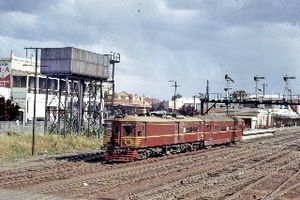
After a train accident in Bowning damaged several passenger cars, two underframes were saved. From these, a two-engine railmotor and a trailer were built. The motor car was named CHP38, and the trailer was 81. It spent most of its time on branch lines out of Narrandera. Trailer 81 was eventually rebuilt and worked shuttles with regular CPH railmotors until electrification in July 1980.
1935 S Type Carriages
Between 1935 and 1937, Clyde Engineering built 35 first-class carriages and 86 second-class side corridor carriages at its Granville factory.
Over the years, they operated on various services, from express passenger and mail trains to branch line services. They started to be removed from service in the 1970s, but some lasted until the late 1980s on mail trains and interurban services.
Between 1974 and 1982, eight of them had their interiors removed and were fitted with suburban seating and new windows for use on interurban services. As of June 1986, 32 were still in service.
Silver City Comet
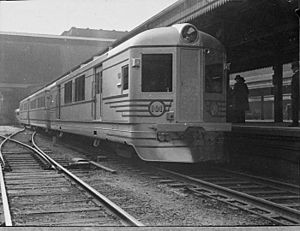
These self-propelled diesel passenger trains were introduced in 1937. They operated between Parkes and Broken Hill. During World War II, they were also used on some intercity runs from Sydney to Canberra and Newcastle. Along with Victoria's "Spirit of Progress", it was the first air-conditioned train in the British Empire.
When first introduced, it was painted silver to reflect the harsh heat of the western plains. After World War II, Silver City Comet trains were repainted in standard NSWGR colors. Before its 50th anniversary in 1987, it was repainted back to its original silver color. The Silver City Comets were removed from service in 1989. Most of the remaining Silver City Comet trains have been preserved.
FP Paybus
The FP paybuses were a series of thirteen small 4-wheel railbuses built for the Department of Railways New South Wales between 1937 and 1970. These railbuses were meant for use on branch lines where there weren't many passengers, so a larger train wasn't needed.
1939 N Type Carriages
In September 1938, the Department of Railways New South Wales ordered 35 steel carriages. They were designed with forced air ventilation and windows that opened downwards. Neither of these features worked well, so they were replaced with more traditional fittings.
The cars were delivered as 5 sets of seven cars. They included first-class cars that seated 56 passengers and second-class cars that seated 78 passengers. There were also second-class brake vans that seated 68 passengers.
In May 1944, they were used on the Newcastle Flyer services until they were replaced by newer trains from 1948. They were also used on the Cessnock Express.
By 1969, some cars were modified to provide additional buffet (food service) sections. A number were also changed into sleeper cars for longer distance trains.
Over the years, they operated on both express passenger and mail train services. They were removed from service in the late 1980s after the Northern and Western Mails trains stopped running.
400/500 Class Railmotor
The 400 & 500 Class rail motors are diesel trains built by New South Wales Government Railways. They were mainly used on regional lines throughout NSW. These trains have since been phased out after many country branch line rail services were changed in November 1983. The 400 Class power cars were built in 1938, while the 500 Class trailer cars were built by Ritchie Brothers.
1948 HUB Set Carriages
The HUB set cars were ordered in 1943 to operate services from Sydney to Newcastle. The original plan was for more N type carriages, but due to wartime limits, construction was delayed. The order was changed to include air-conditioned carriages, and 3 more cars were added. The contract was given to Tulloch Limited, who built the 28 carriages between 1947 and 1949. They formed four sets of seven carriages.
The first set started service in April 1948 on the Newcastle Flyer. One briefly operated the Riverina Express before being moved to the South Coast Daylight Express and then in 1956 to the Central West Express.
From the 1970s, the HUB sets stopped operating as fixed groups. The carriages were used with RUB and stainless steel trains on services across the state.
They stopped operating the Newcastle Flyer services in April 1988, and many were removed from service as a number of locomotive-hauled services stopped in the early 1990s. Some remained in service with CityRail on Southern Highlands services to Goulburn until they were replaced by Endeavour railcars in 1994.
Most were sold at auction in August 1994, with the State Rail Authority keeping five. In 1996, three were brought back into service for CountryLink's new services to Broken Hill and Griffith before being removed again in April 2000.
600/700 Railmotor
The 600/700 class railcars were a type of Diesel Multiple Unit built by the New South Wales Government Railways. They were built to operate on branch lines from 1949 with low traffic. Later, they were moved to Newcastle and Wollongong to operate suburban services until they were removed from service in 1994. However, one 600 class railcar was converted to run on solar power for the Byron Bay Train service. This upgraded train started service on December 16, 2017, and is believed to be the world's first solar-powered train.
1949 RUB Set Carriages
The RUB type carriage stock was a type of steel-bodied, air-conditioned passenger carriage operated by the New South Wales Government Railways from September 1949 until April 2000.
900/800 Class Diesel Rail Motors
From 1955 until 1990, air-conditioned 800/900 class trains, known as DEB sets, provided service to Canberra as the Canberra Monaro Express. These replaced the steam-hauled Federal City Express. The DEB sets were also used on some South Coast Line and Southern Highlands Line commuter services until they were replaced by Endeavour railcars in 1994.
1961 Stainless Steel Carriages
The New South Wales stainless steel carriage stock was a type of passenger carriage operated by the New South Wales Government Railways from 1961 until 1993. These carriages were mainly used on trains that traveled between states, like the Southern Aurora (between Sydney and Melbourne) and the Brisbane Limited. They were also used on the Gold Coast Motorail.
When locomotive-hauled trains stopped running, most of these carriages went to historical societies and museums. They have kept them in working condition. The New South Wales Rail Transport Museum often uses them on tours under the Southern Aurora name.
Current Regional Passenger Trains
XPT
The XPT (express passenger train) is the main train for country passenger services in NSW. It was based on the British HST and introduced from 1982. They currently provide service from Sydney to Melbourne, Brisbane, Dubbo, Grafton, and Casino. An XPT train can have between four and seven cars, depending on how many people are traveling.
Initially, the XPT was painted mostly red, with black and orange. This striking look inspired the "candy-stripe" paint scheme used on other trains from 1982. The first CountryLink repaint was in 1991, and a new CountryLink look was introduced in 2008. The first XPT, XP2000, has appeared in special paint schemes for the Sydney 2000 Games and the 2001 Centenary of Federation. In the early 1990s, sleeping cars were added to the XPT trains after protests when older sleeping car trains were cancelled.
Xplorer
The Xplorer is a diesel self-propelled multiple unit train, introduced from 1993. They provide services to Canberra, Griffith, Moree, Armidale, and Broken Hill. They are very similar in technology and mechanics to NSW TrainLink's Endeavour railcars, but they have a buffet service and a higher standard of comfort.
New Regional Trains (Future)
The NSW TrainLink Regional Train Project is a plan by Transport for NSW to get new trains to replace the NSW TrainLink's Endeavour, Xplorer, and XPT trains.
The order includes 117 bi-mode Civity carriages. These will make up 10 long (6-car) trainsets for long-distance services connecting Sydney, Melbourne, and Brisbane. Plus, there will be 9 short (3-car) Regional trainsets for NSW and 10 short (3-car) Intercity sets for the Southern Highlands – a total of 29 trains. The bi-mode units can run on electricity in NSW where there are overhead power lines, but they will use diesel power in Melbourne or Brisbane.
Intercity/Regional Passenger Locomotives
6 Class
The 6 class included engines 6 and 7, built in 1856. They had a 2-2-2 wheel setup.
9 Class
The 9 class was built in 1858. It was designed to carry both passengers and coal, with a 2-2-2 wheel setup.
G23 Class
The G23 class was built in 1863, as a 2-4-0 engine. It was called the 23 class until 1890.
8N Class
The 8N class was built for the northern part of the railway network in 1864.
Light Rail Trains
The light rail systems in Sydney and Newcastle use their own special trains. The Parramatta Light Rail is separate from the rest of Sydney's light rail network.
Train Codes
|
Letters on passenger vehicles often mean:
|
Electric vehicles use these letters:
Suburban electric trains use one-letter codes. Inter-urban electric trains use two or three-letter codes:
|
Current and Future Trains (Bold)
- A = Waratah Series 1, 1877 American carriage stock
- B = Waratah Series 2, Punchbowl red rattlers (Bradfield, Standard, Tulloch)
- BPH = Creamy Kate Railmotor
- C = Chopper C set
- CPH = Tin Hare Railmotor
- D = New Intercity Fleet D set
- DEB = 900/800 class railmotors
- E = 620/720 class railcar
- F = Flemington Red Rattlers (Bradfield, Standard, Tulloch)
- G = G set Tangara, converted to T1 set in 2010
- H = OSCAR (Outer Suburban Cars), Hornsby red rattlers (Bradfield, Standard, Tulloch)
- J = Hunter Railcar
- K = K Set
- L = L set, post 1988
- M = Proposed for the Tangara, later changed to T set. Millennium, Mortdale Red Rattlers
- N = Endeavour
- P = Xplorer
- R = R set (retired)
- S = Sputnik carriage stock (single and double deck), see W set. S Set (retired)
- T = 2 car S set, see L set. Tangara
- T1 = Ex G sets, compatible with T set
- V = V set
- W = Sputnik carriage stock, post 1972.
- X = XPT (express passenger train)
- Y = 3 car V sets for testing - Not for passenger service


